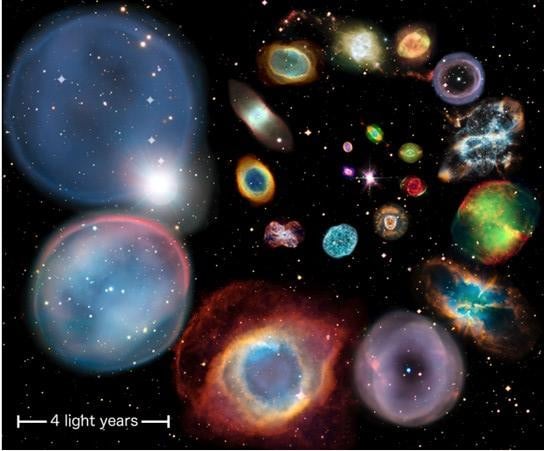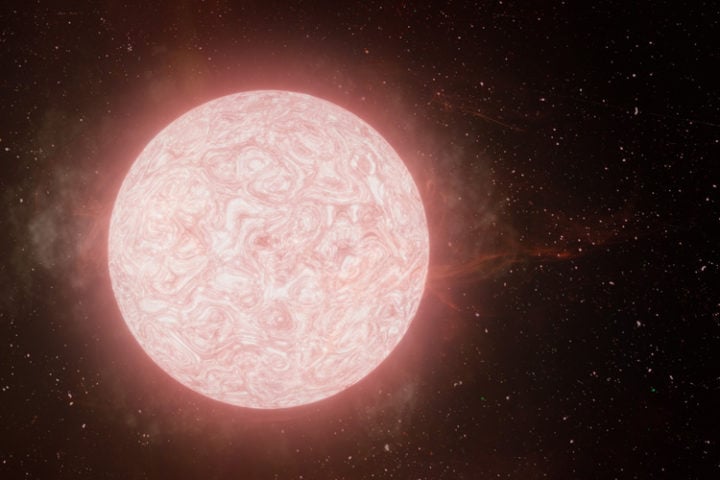
A now iconic collage showing 22 individual well-known PNe, artistically arranged in a spiral pattern by order of approximate physical size. Image credit: University of Manchester
The alignment of planetary nebulae was discovered ten years ago by a Manchester PhD student, Bryan Rees, but has remained unexplained.
New data obtained with the European Southern Observatory Very Large Telescope in Chile and the Hubble Space Telescope, published in Astrophysical Journal Letters, has confirmed the alignment but also found a particular group of stars that is responsible, namely close binary stars.
Planetary nebulae are clouds of gas that are expelled by stars at the end of their lives – the Sun will also form one about five billion years from now. The ejected clouds are ‘ghosts’ of their dying stars and they form beautiful structures such as an hourglass or butterfly shape.

An artist’s impression of a red supergiant in the final year of its life emitting a massive cloud of gas. Image courtesy of W. M. Keck Observatory/Adam Makarenko
The team studied a group of so-called planetary nebulae found in the Galactic Bulge near the centre of our Milky Way. Each of these nebulae are unrelated and come from different stars, which were born at different times, and spend their lives in completely different places.
However, the study found that many of their shapes line up in the sky in the same way and are aligned almost parallel to the Galactic plane (our Milky Way).
This is in the same direction as found by Bryan Rees a decade ago.
The new research, led by Shuyu Tan, a student at the University of Hong Kong, found that the alignment is present only in planetary nebulae which have a close stellar companion. The companion star orbits the main star at the centre of the planetary nebulae in an orbit closer than Mercury is to our own Sun.
The planetary nebulae that do not show close companions do not show the alignment, which suggests that the alignment is potentially linked to the initial separation of the binary components at the time of the star’s birth.

Milky Way – artistic impression. Image credit: Pxhere, CC0 Public Domain
Albert Zijlstra, co-author and Professor in Astrophysics at The University of Manchester, said: “This finding pushes us closer to understanding the cause for this mysterious alignment.
“Planetary nebulae offer us a window into the heart of our galaxy and this insight deepens our understanding of the dynamics and evolution of the Milky Way’s bulge region.
“The formation of stars in the bulge of our galaxy is a complex process that involves various factors such as gravity, turbulence, and magnetic fields. Until now, we have had a lack of evidence for which of these mechanisms could be causing this process to happen and generating this alignment.
“The significance in this research lies in the fact that we now know that the alignment is observed in this very specific subset of planetary nebulae.”
The researchers investigated 136 confirmed planetary nebulae in the galaxy bulge – the thickest section of our Milky Way composed of stars, gas and dust – using the European Southern Observatory Very Large Telescope, which has a main mirror diameter of eight metres.
They also re-examined and re-measured 40 of these from the original study using images from the high-resolution Hubble Space Telescope.
Prof Quentin Parker, the corresponding author from the University of Hong Kong, suggests the nebulae may be shaped by the rapid orbital motion of the companion star, which may even end up orbiting inside the main star.
The alignment of the nebulae may mean that the close binary system preferentially forms with their orbits in the same plane.
Although further studies are needed to fully understand the mechanisms behind the alignment, the findings provide important evidence for the presence of a constant and controlled process that has influenced star formation over billions of years and vast distances.
Source: University of Manchester

